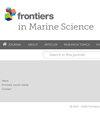南海中新世以来珊瑚礁碳酸盐岩岩溶作用特征及主控因素
IF 3
2区 生物学
Q1 MARINE & FRESHWATER BIOLOGY
引用次数: 0
摘要
珊瑚礁岩溶作用在海气二氧化碳交换中起着至关重要的作用,但其机制尚不清楚。本文利用南海西沙群岛CK2井878.22 m (19.6 Ma)的珊瑚礁层序,研究了其岩溶作用过程,包括它们的特征、主要控制因素以及对全球碳循环中海相碳酸盐溶解的影响。岩石学和地球化学分析表明,CK2具有明显的岩溶作用特征,包括:(1)表面孔隙度较高,25 ~ 30%),孔隙和裂缝大小、形状各异,分布随机;(2)黄褐色至黑色浸渍物;(3)泥晶胶结物伴有较好结晶的矿物晶体;(4)分选较好的圆形颗粒。地球化学特征显示8787Sr/86Sr、Mn含量和Mn/Sr比值升高,δ1³C、δ 18o和Sr含量降低。这些特征共同表明,CK2的岩溶作用以非选择性溶解和再结晶过程为主,主要发生在长期暴露于地面的大气水系统的混合带。不同地质时期的岩溶特征不同,暗示着不同的控制机制。晚中新世(12.6 ~ 10.2 Ma)在海平面持续下降的驱动下,表现出87Sr/86Sr的极端移位和严重的侵蚀。更新世(2.2 ~ 1.8、1.1 ~ 0.89、0.29和0.2 Ma)受频繁的海平面波动和与冰期-间冰期旋回和亚洲季风相关的温暖湿润环境的影响,地表孔隙率最高(15 ~ 40%,平均25%),呈现赭色至黄褐色浸渍和微晶化胶结物,δ¹³-δ18O为负,87Sr/86Sr和Mn/Sr比值升高。相比之下,中中新世气候优化期(16.6 ~ 16 Ma)缺乏典型的喀斯特特征,但由圆润且分选的珊瑚砾石组成,表明造礁生物通过基质结构介导喀斯特作用。这些发现表明,海平面变化和气候条件控制着珊瑚礁岩溶作用的强度。同时,岩溶过程中的溶蚀作用可能显著改变海洋碱度和溶解的无机碳,并对未来气候情景下的碳循环具有潜在的反馈作用。本文章由计算机程序翻译,如有差异,请以英文原文为准。
Characteristics and primary controls of coral reef carbonate karstification in the South China Sea since the Miocene
Coral reef karstification plays a vital role in sea-air CO2 exchange, yet its mechanisms remain unclear. This study employs an 878.22-m coral reef sequence (dating to19.6 Ma) from Well CK2 in the Xisha Islands, South China Sea (SCS), to investigate karstification processes, including their signatures, primary controls, and implications for marine carbonate dissolution in global carbon cycling. Petrological and geochemical analyses of CK2 revel distinct karstification characteristics, including: (1) higher surface porosity 25–30%), with randomly distributed pores and fractures of variable sizes and shapes; (2) yellowish-brown to black impregnations; (3) micritic cements accompanied by well-crystallized mineral crystals, and (4) moderately well-sorted and rounded grains. Geochemical signatures show elevated 8787 Sr/86 Sr, Mn content, and Mn/Sr ratios, coupled with depleted δ¹³C, δ18 O and Sr content. These features collectively indicate that karstification in CK2 was dominated by non-selective dissolution and recrystallization processes, principally occurring at the mixing zone in meteoric water systems during prolonged subaerial exposure. Karstification signatures varied across geological epochs, implying different controlling mechanisms. Late Miocene (12.6–10.2 Ma), driven by sustained sea-level fall, exhibited an extreme 87 Sr/86 Sr shift and severe erosion. Pleistocene (2.2–1.8, 1.1–0.89, 0.29 and 0.2 Ma), influenced by frequent sea-level fluctuations and warm, humid environments linked to glacial-interglacial cycle and Asian monsoon, displayed the highest surface porosity (15–40%, mean 25%), ochre to tawny impregnations, and micritized cements, along with negative δ¹³C-δ18 O and elevated 87 Sr/86 Sr and Mn/Sr ratios. In contrast, the Middle Miocene Climatic Optimum (16.6–16 Ma) lacked typical karst characteristics but comprised of well-rounded and sorted coral gravels, suggesting reef-building organisms mediate karstification via substrate architecture. These findings demonstrate that sea-level changes and climate conditions control coral reef karstification intensity. Concurrently, dissolution during karstification may significantly modify ocean alkalinity and dissolved inorganic carbon, with potential feedback on carbon cycling in future climate scenarios.
求助全文
通过发布文献求助,成功后即可免费获取论文全文。
去求助
来源期刊

Frontiers in Marine Science
Agricultural and Biological Sciences-Aquatic Science
CiteScore
5.10
自引率
16.20%
发文量
2443
审稿时长
14 weeks
期刊介绍:
Frontiers in Marine Science publishes rigorously peer-reviewed research that advances our understanding of all aspects of the environment, biology, ecosystem functioning and human interactions with the oceans. Field Chief Editor Carlos M. Duarte at King Abdullah University of Science and Technology Thuwal is supported by an outstanding Editorial Board of international researchers. This multidisciplinary open-access journal is at the forefront of disseminating and communicating scientific knowledge and impactful discoveries to researchers, academics, policy makers and the public worldwide.
With the human population predicted to reach 9 billion people by 2050, it is clear that traditional land resources will not suffice to meet the demand for food or energy, required to support high-quality livelihoods. As a result, the oceans are emerging as a source of untapped assets, with new innovative industries, such as aquaculture, marine biotechnology, marine energy and deep-sea mining growing rapidly under a new era characterized by rapid growth of a blue, ocean-based economy. The sustainability of the blue economy is closely dependent on our knowledge about how to mitigate the impacts of the multiple pressures on the ocean ecosystem associated with the increased scale and diversification of industry operations in the ocean and global human pressures on the environment. Therefore, Frontiers in Marine Science particularly welcomes the communication of research outcomes addressing ocean-based solutions for the emerging challenges, including improved forecasting and observational capacities, understanding biodiversity and ecosystem problems, locally and globally, effective management strategies to maintain ocean health, and an improved capacity to sustainably derive resources from the oceans.
 求助内容:
求助内容: 应助结果提醒方式:
应助结果提醒方式:


